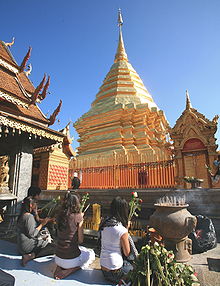- Offering (Buddhism)
-
 Worshippers making offerings of incense, flowers and candles to a chedi at Wat Doi Suthep, Chiang Mai, Thailand
Worshippers making offerings of incense, flowers and candles to a chedi at Wat Doi Suthep, Chiang Mai, Thailand
Lay Buddhist
Practices

devotional Offerings · Bows
3 Refuges · Chantingprecepts 5 Precepts · 8 Precepts
Bodhisattva vowsother Meditation · Giving
Supporting Monastics
Study · Pilgrimageview · Buddhism, symbolic offerings are made to the Triple Gem, giving rise to contemplative gratitude and inspiration.[1] Typical material offerings involve simple objects such as a lit candle or oil lamp,[2] burning incense,[3] flowers,[4] food, fruit, water or drinks.[5] Contemporary Western practitioners often find the making of offerings to be occasions for gracious mindfulness.[6] Within the traditional Buddhist framework of karma and rebirth, offerings also lead to:
-
- a better rebirth in the cycle of birth and death (Pali: vattagamini-kusala)
- progress towards release from suffering (Pali: vivattagamini-kusala).[7]
These offerings often act as preparation for meditation.[8]
Contents
Theravada practices
Material offerings nurture generosity (Pali:dāna) and virtue (Pali: sīla).[9] The act further honors the Triple Gem (the Buddha, Dhamma and Sangha), deepening one's commitment to the Buddha's path. For instance, traditional chants (in English and Pali) when offering lit candles (padīpa pūjā) and incense (sugandha pūjā) to an image of the Buddha are:
With lights brightly shining
Abolishing this gloom
I adore the Enlightened One,
The Light of the three worlds.
With perfumed incense
And fragrant smoke
I worship the Exalted One,
Who is great and worthy of worship.[10]Ghanasārappadittena
Dīpena tama-dhaṃsinā
Tiloka-dīpaṃ sambuddhaṃ
Pūjayāmi tamo-nudaṃ
Ghandha-sambhāra-yuttena
Dhūpenāhaṃ sugandhinā
Pūjaye pūjaneyyaṃ taṃ
Pūjābhajanamuttamaṃ[11]Similarly, a traditional Pali incense-lighting verse speaks of the Buddha's "fragrant body and fragrant face, fragrant with infinite virtues."[12]
By contemplating on an offering, one tangibly sees life's impermanence (Pali: anicca), one of the three characteristics of all things upon which the Buddha encouraged his disciplines to recollect. For instance, the end of a traditional chant (in English and Pali) when offering flowers (puppha pūjā) to an image of the Buddha is:
I worship the Buddha with these flowers;
May this virtue be helpful for my emancipation;
Just as these flowers fade,
Our body will undergo decay.[13]Pujemi Buddham kusumenanena
Puññenametena ca hotu mokkham
Puppham milāyāti yathā idam me
Kāyo tathā yāti vināsa-bhavam[11]Mahayana practices
Mahayana material offerings might be imbued with the following symbology:
- the lighting of a candle or an oil lamp represents the light of wisdom illuminating the darkness of ignorance.
- the burning of incense represents the fragrant scent of morality.
- flowers represents the aspiration to achieve the body of the Buddha with the thirty-two marks of the Buddha as well as the teaching of impermanence. Alternately, a Zen verse expresses the desire for the mind's "flowers" to "bloom in the springtime of enlightenment."[14]
- food, fruit, water, drinks represents the nectar of Dharma and the wish to achieve it.
In Northern Buddhism, sacred images have set before them:
- water (representing hospitality, to wash the face and feet)
- scarves (Tib. kha-btags, offering friendship)
- flowers, incense, lamps, perfume and food (representing one's devoting all their senses to their spiritual practice).[12]
Non-material offerings
In some traditions, two different types of offerings are identified:
- material or hospitality offerings (Pali: amisa-puja[15] or sakkara-puja[16])[17]
- practice offerings (Pali: patipatti-puja[18])
In this context, material offerings are considered external offerings of "words and deeds."[15]
Practice offerings may be manifested by practicing:
In the Pali Canon, the Buddha declared practice offerings as "the best way of honoring the Buddha"[20] and as the "supreme" offering.[15] This is primarily an internal offering for mental development (Pali: citta, bhāvanā and samādhi).
See also
- Almsgiving (Buddhism)
- Chanting (Buddhism)
- Meditation (Buddhism)
- Dana (Buddhism)
- Householder (Buddhism)
- Phan (tray)
- Prostration (Buddhism)
- Puja (Buddhism)
- Recollection (Buddhism)
Notes
- ^ See, for instance, Harvey (1990), pp. 172-3.
- ^ Indaratana (2002), pp. iv, v; Kapleau (1989), p. 193; Khantipalo (1982); Lee & Thanissaro (1998).
- ^ Indaratana (2002), pp. 11-12.
- ^ See, for instance, Indaratana (2002), pp. 11-12. Harvey (1990), p. 173, and Kariyawasam (1995), chapter 1, both maintain that flowers are the most common form of offering.
- ^ Kapleau (1989), p. 193; Khantipalo (1982); and, Harvey (1990), p. 175, particularly in regards to Northern Buddhism.
- ^ Such an appreciation might be experienced, for instance, by those practicing in the style of Thich Nhat Hanh.
- ^ Lee & Thanissaro (1998). See also Harvey (1990), p. 173, who in discussing "offerings" states: "Such acts consequently generate 'merit'."
- ^ See, for instance, Indaratana (2002), p. v; Kapleau (1989), pp. 191ff.; and Khantipalo (1982).
- ^ See, for instance, Lee & Thanissaro (1998).
- ^ Indaratana (2002), p. 11. See also Harvey (1990), p. 175, who translates the light-offering verse in part as describing the Buddha as "the lamp of the three worlds, dispeller of darkness."
- ^ a b Indaratana (2002), p. 12.
- ^ a b Harvey (1990), p. 175.
- ^ Indaratana (2002), p. 11. Similarly, see Harvey (1990), p. 173; and, Kariyawasam (1995), ch. 1, sect. 2, "Personal Worship."
- ^ Harvey (1990), p. 173.
- ^ a b c Lee & Thanissaro (1998).
- ^ Khantipalo (1982).
- ^ See also Alms#Buddhism regarding the traditional Theravada offering of providing daily alms to bhikkhus.
- ^ Khantipalo (1982); Lee & Thanissaro (1998).
- ^ Khantipalo (1982); and, Nyanaponika (2000), pp. 298-299. On the other hand, Lee & Thanissaro (1998) identify only meditation as patipatti-puja.
- ^ Kantipalo (1982), n. 1.
Bibliography
- Harvey, Peter (1990). An introduction to Buddhism: Teachings, history and practices. Cambridge: Cambridge University. ISBN 0-521-31333-3.
- Indaratana Maha Thera, Elgiriye (2002). Vandana: The Album of Pali Devotional Chanting and Hymns. Penang, Malaysia:Mahindarama Dhamma Publication. Retrieved 2007-10-22 from "BuddhaNet" at http://www.buddhanet.net/pdf_file/vandana02.pdf.
- Kariyawasam, A.G.S. (1995). Buddhist Ceremonies and Rituals of Sri Lanka (The Wheel Publication No. 402/404). Kandy, Sri Lanka: Buddhist Publication Society. Retrieved 2007-10-23 from "Access to Insight" (1996 transcription) at http://www.accesstoinsight.org/lib/authors/kariyawasam/wheel402.html#ch3.
- Kapleau, Philip (1989b). Zen: Merging of East and West. NY:Anchor Book. ISBN 0-385-26104-7.
- Khantipalo, Bhikkhu (1982). Lay Buddhist Practice: The Shrine Room, Uposatha Day, Rains Residence (The Wheel No. 206/207). Kandy, Sri Lanka:Buddhist Publication Society. Retrieved 2007-10-22 from "Access to Insight" (transcribed 1995) at http://www.accesstoinsight.org/lib/authors/khantipalo/wheel206.html.
- Lee Dhammadharo, Ajaan & Thanissaro Bhikkhu (trans.) (1998). Visakha Puja. Retrieved 2007-10-22 from "Access to Insight" at http://www.accesstoinsight.org/lib/thai/lee/visakha.html.
- Nyanaponika Thera (2000). The Vision of Dhamma: Buddhist Writings of Nyanaponika Thera. Seattle: BPS Pariyatti Editions. ISBN 1-928706-03-7.
- Soni, R.L. & Bhikkhu Khantipalo (2006). Life's Highest Blessings: The Maha Mangala Sutta. Retrieved 2007-10-22 from "Access to Insight" at http://www.accesstoinsight.org/lib/authors/soni/wheel254.htm.
External links
- About the Buddha-altar Soto Zen home altar with offerings.
- Offerings are a major part of the ritual of Tibetan Buddhism
- Virtual Puja at Emerald Buddha Temple-วัดพระแก้ว
v · d · eBuddhism Buddhism portal Categories:- Buddhist practices
Wikimedia Foundation. 2010.
Look at other dictionaries:
Offering — may refer to: Offering, a collection of donations during religious worship, see alms, tithe or charity Offering, a religious sacrifice of plant, animal or human life Offering (Buddhism), a part of devotional practice Phan (tray) Securities… … Wikipedia
Buddhism in the United States of America — Buddhism is a religion with millions of followers in the United States, including traditionally Buddhist Asian Americans as well as non Asians, many of whom are converts [ [http://www.beliefnet.com/story/7/story 732 1.html Beliefnet.com American… … Wikipedia
Buddhism and Hinduism — are two closely related religions that are in some ways parallel each other and in other ways are divergent in theory and practice.The Vedic, Buddhist, and Jain religions share a common regional culture situated near and around north eastern… … Wikipedia
Buddhism — Buddhist, n., adj. Buddhistic, Buddhistical, adj. Buddhistically, adv. /booh diz euhm, bood iz /, n. a religion, originated in India by Buddha (Gautama) and later spreading to China, Burma, Japan, Tibet, and parts of southeast Asia, holding that… … Universalium
Buddhism in Singapore — As of 2000, 42.5% of the Singaporeans register themselves as Buddhist by religion. Adherents of Buddhism are mostly by the Chinese majority ethnic group, although small minorities of Sinhalese and Thai Buddhists do exist as well. Chinese Mahayana … Wikipedia
Buddhism in Nepal — Part of a series on Buddhism Outline · Portal History Timeline · Councils … Wikipedia
Buddhism in Korea — Korean Buddhism is distinguished from other forms of Buddhism by its attempt to resolve what it sees as inconsistencies in Mahayana Buddhism. Early Korean monks believed that the traditions they received from China were internally inconsistent.… … Wikipedia
Buddhism in Central Asia — [ Tarim Basin, China, 9th 10th century.] Although Buddhism never developed a missionary movement [ [http://www.buddhistview.com/site/epage/8069 225.htm THE SPREAD OF BUDDHISM] ] , Buddha s teachings nevertheless spread far and wide on the Indian… … Wikipedia
Puja (Buddhism) — In Buddhism, puja (Pali: pūjā ) are expressions of honour, worship, devotional attention. [Rhys Davids Stede (1921 25), p. 471, entry for Pūjā, available at http://dsal.uchicago.edu/cgi bin/philologic/getobject.pl?c.2:1:2985.pali (retrieved 2007… … Wikipedia
Householder (Buddhism) — DisplayTranslations title=Translations of Householder bordercolor=#af4630 | borderwidth=2px headercolor=#FFD068 | headertextcolor=DarkBlue rowcolor=#FFFEE8 | rowtextcolor=purple fontsize=100% English | householder Pali | IAST|gihin, gahattha,… … Wikipedia
18+© Academic, 2000-2025- Contact us: Technical Support, Advertising
Dictionaries export, created on PHP, Joomla, Drupal, WordPress, MODx.Share the article and excerpts
-
Offering (Buddhism)
- Offering (Buddhism)
-
 Worshippers making offerings of incense, flowers and candles to a chedi at Wat Doi Suthep, Chiang Mai, Thailand
Worshippers making offerings of incense, flowers and candles to a chedi at Wat Doi Suthep, Chiang Mai, Thailand
Lay Buddhist
Practices

devotional Offerings · Bows
3 Refuges · Chantingprecepts 5 Precepts · 8 Precepts
Bodhisattva vowsother Meditation · Giving
Supporting Monastics
Study · Pilgrimage

